CHEVROLET SSR 2004 1.G Owners Manual
Manufacturer: CHEVROLET, Model Year: 2004, Model line: SSR, Model: CHEVROLET SSR 2004 1.GPages: 398, PDF Size: 2.49 MB
Page 321 of 398
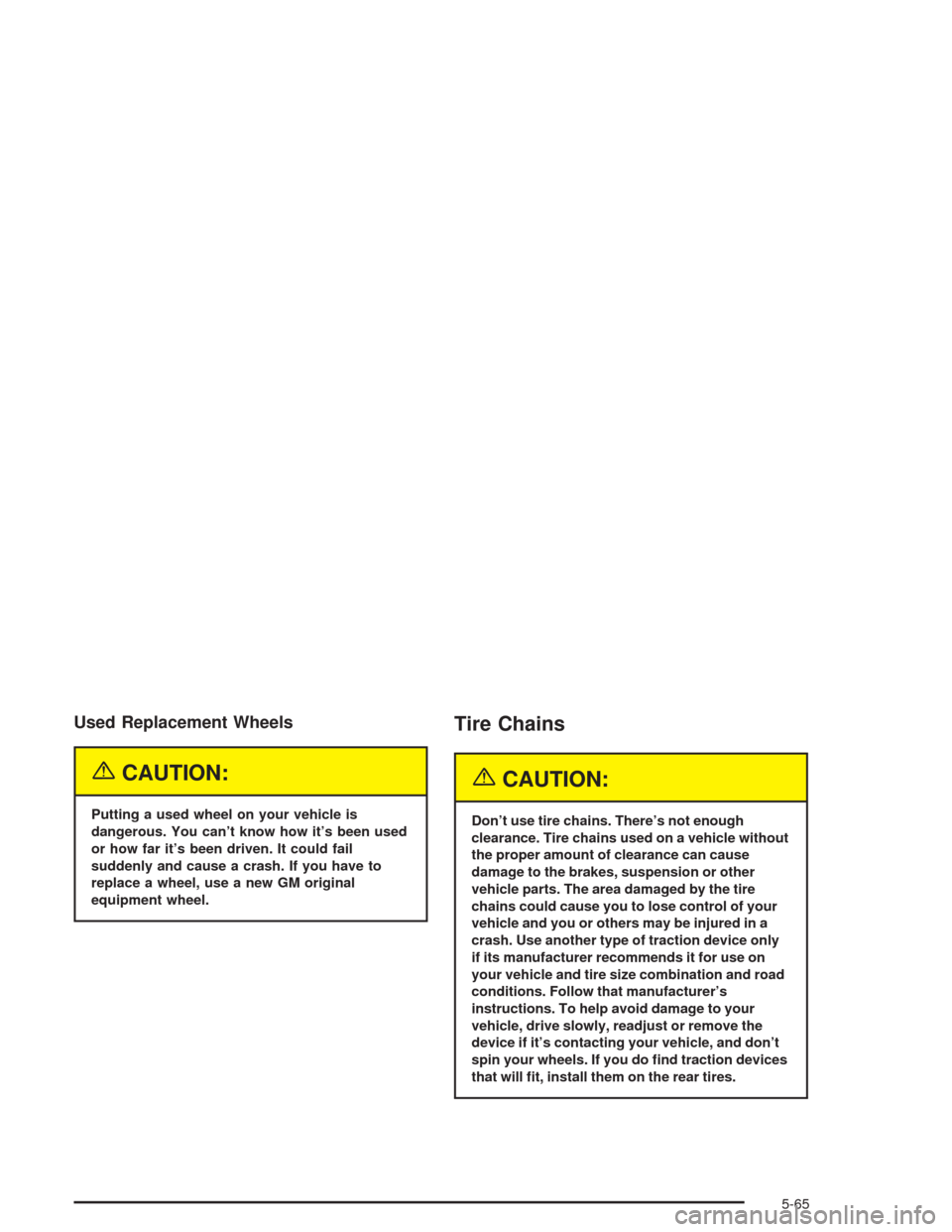
Used Replacement Wheels
{CAUTION:
Putting a used wheel on your vehicle is
dangerous. You can’t know how it’s been used
or how far it’s been driven. It could fail
suddenly and cause a crash. If you have to
replace a wheel, use a new GM original
equipment wheel.
Tire Chains
{CAUTION:
Don’t use tire chains. There’s not enough
clearance. Tire chains used on a vehicle without
the proper amount of clearance can cause
damage to the brakes, suspension or other
vehicle parts. The area damaged by the tire
chains could cause you to lose control of your
vehicle and you or others may be injured in a
crash. Use another type of traction device only
if its manufacturer recommends it for use on
your vehicle and tire size combination and road
conditions. Follow that manufacturer’s
instructions. To help avoid damage to your
vehicle, drive slowly, readjust or remove the
device if it’s contacting your vehicle, and don’t
spin your wheels. If you do �nd traction devices
that will �t, install them on the rear tires.
5-65
Page 322 of 398
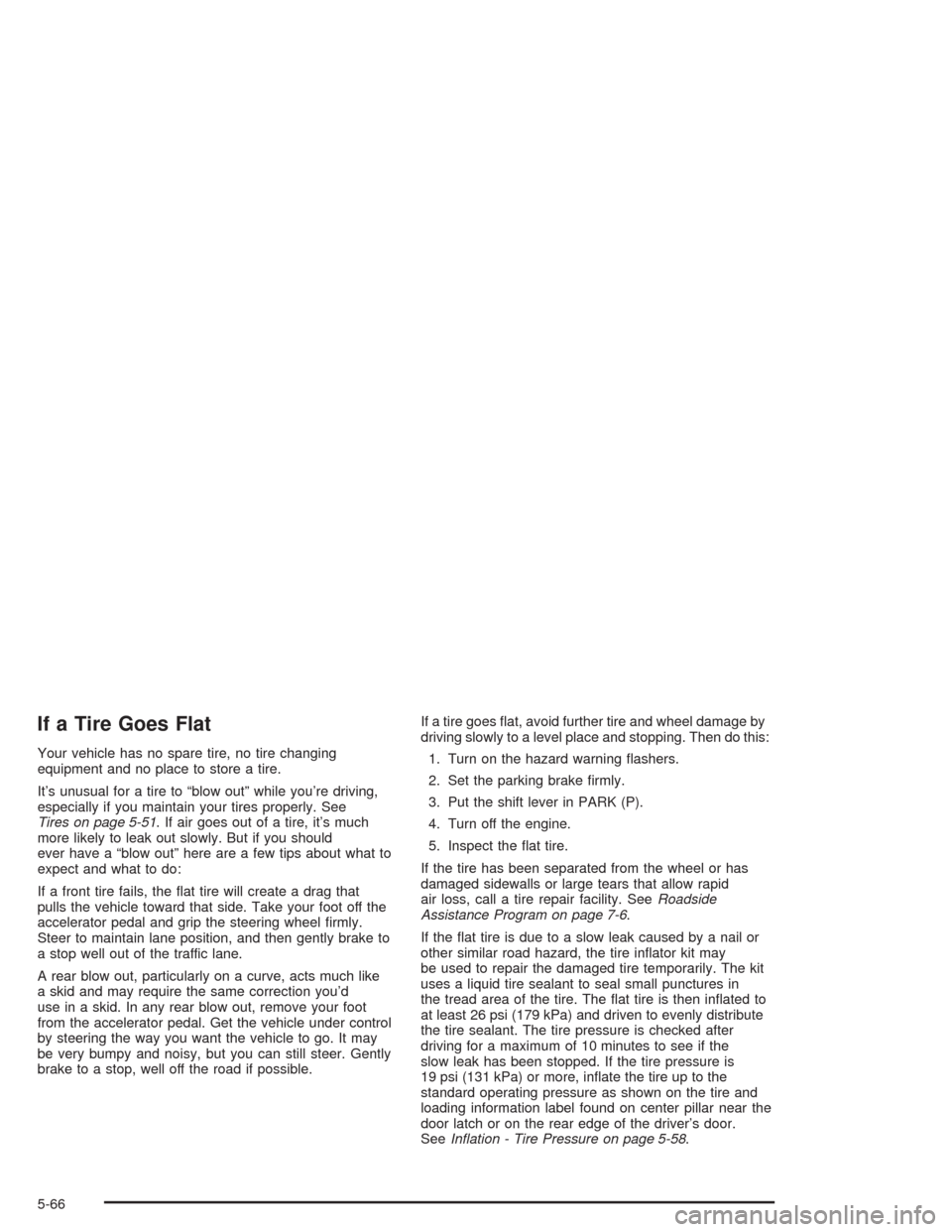
If a Tire Goes Flat
Your vehicle has no spare tire, no tire changing
equipment and no place to store a tire.
It’s unusual for a tire to “blow out” while you’re driving,
especially if you maintain your tires properly. See
Tires on page 5-51. If air goes out of a tire, it’s much
more likely to leak out slowly. But if you should
ever have a “blow out” here are a few tips about what to
expect and what to do:
If a front tire fails, the �at tire will create a drag that
pulls the vehicle toward that side. Take your foot off the
accelerator pedal and grip the steering wheel �rmly.
Steer to maintain lane position, and then gently brake to
a stop well out of the traffic lane.
A rear blow out, particularly on a curve, acts much like
a skid and may require the same correction you’d
use in a skid. In any rear blow out, remove your foot
from the accelerator pedal. Get the vehicle under control
by steering the way you want the vehicle to go. It may
be very bumpy and noisy, but you can still steer. Gently
brake to a stop, well off the road if possible.If a tire goes �at, avoid further tire and wheel damage by
driving slowly to a level place and stopping. Then do this:
1. Turn on the hazard warning �ashers.
2. Set the parking brake �rmly.
3. Put the shift lever in PARK (P).
4. Turn off the engine.
5. Inspect the �at tire.
If the tire has been separated from the wheel or has
damaged sidewalls or large tears that allow rapid
air loss, call a tire repair facility. SeeRoadside
Assistance Program on page 7-6.
If the �at tire is due to a slow leak caused by a nail or
other similar road hazard, the tire in�ator kit may
be used to repair the damaged tire temporarily. The kit
uses a liquid tire sealant to seal small punctures in
the tread area of the tire. The �at tire is then in�ated to
at least 26 psi (179 kPa) and driven to evenly distribute
the tire sealant. The tire pressure is checked after
driving for a maximum of 10 minutes to see if the
slow leak has been stopped. If the tire pressure is
19 psi (131 kPa) or more, in�ate the tire up to the
standard operating pressure as shown on the tire and
loading information label found on center pillar near the
door latch or on the rear edge of the driver’s door.
SeeIn�ation - Tire Pressure on page 5-58.
5-66
Page 323 of 398
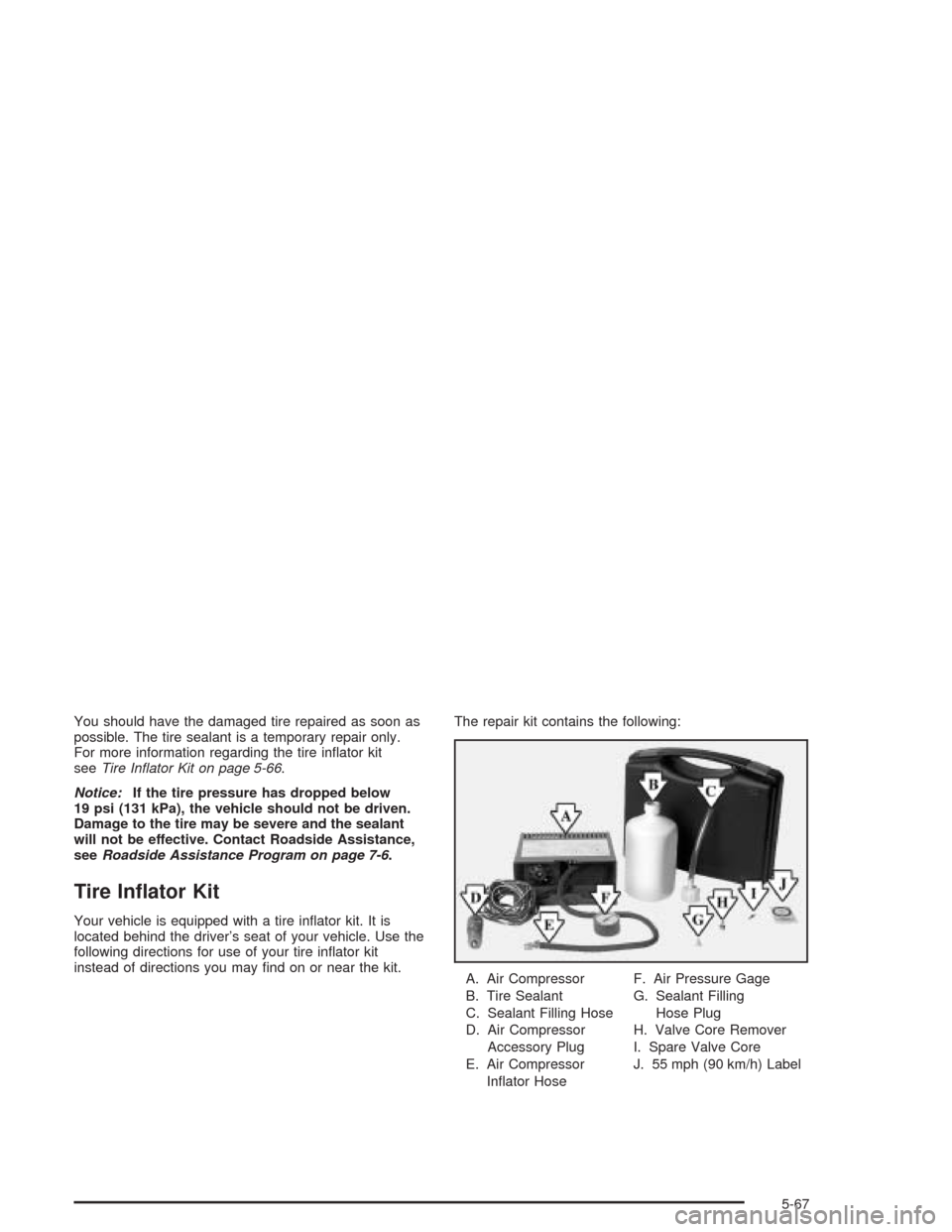
You should have the damaged tire repaired as soon as
possible. The tire sealant is a temporary repair only.
For more information regarding the tire in�ator kit
seeTire In�ator Kit on page 5-66.
Notice:If the tire pressure has dropped below
19 psi (131 kPa), the vehicle should not be driven.
Damage to the tire may be severe and the sealant
will not be effective. Contact Roadside Assistance,
seeRoadside Assistance Program on page 7-6.
Tire In�ator Kit
Your vehicle is equipped with a tire in�ator kit. It is
located behind the driver’s seat of your vehicle. Use the
following directions for use of your tire in�ator kit
instead of directions you may �nd on or near the kit.The repair kit contains the following:
A. Air Compressor
B. Tire Sealant
C. Sealant Filling Hose
D. Air Compressor
Accessory Plug
E. Air Compressor
In�ator HoseF. Air Pressure Gage
G. Sealant Filling
Hose Plug
H. Valve Core Remover
I. Spare Valve Core
J. 55 mph (90 km/h) Label
5-67
Page 324 of 398
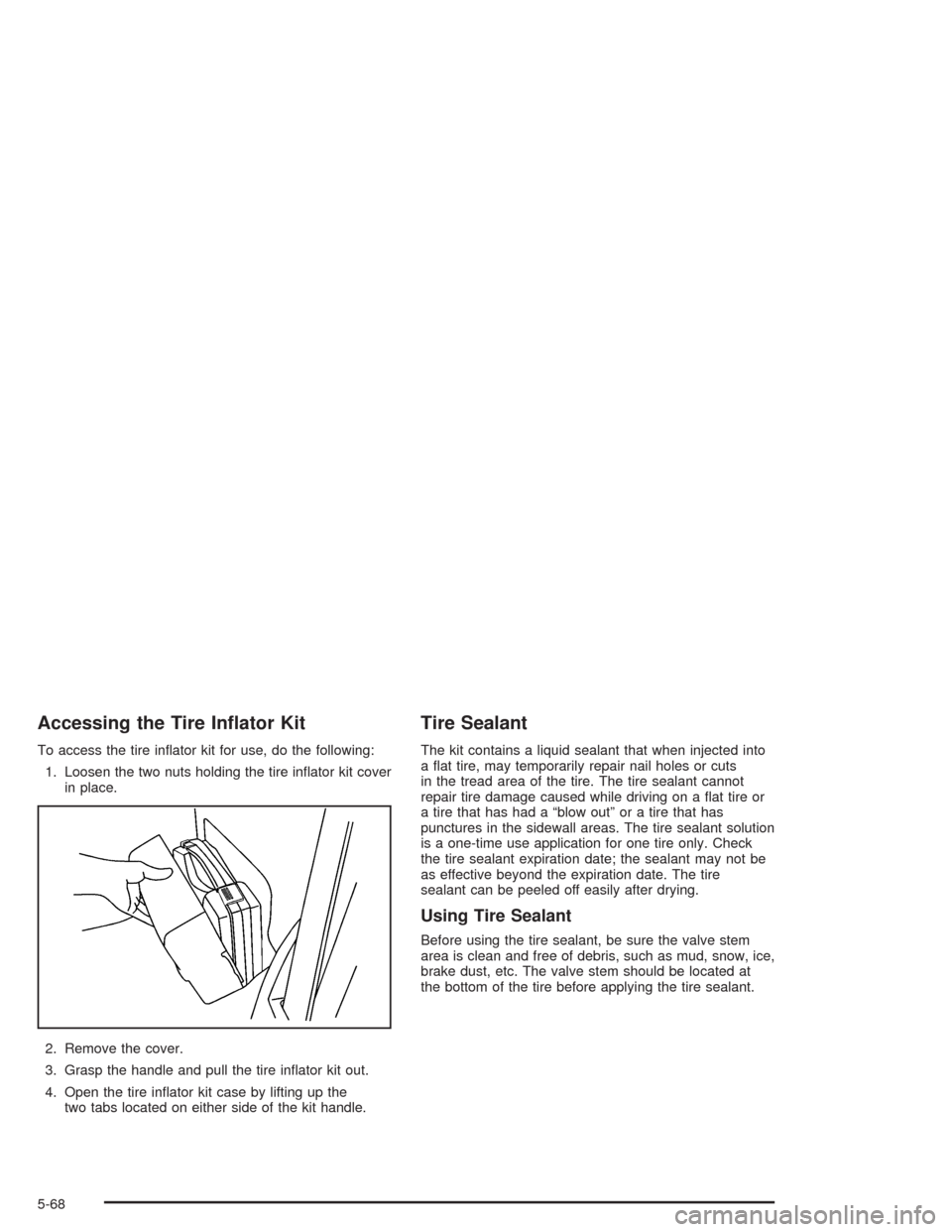
Accessing the Tire In�ator Kit
To access the tire in�ator kit for use, do the following:
1. Loosen the two nuts holding the tire in�ator kit cover
in place.
2. Remove the cover.
3. Grasp the handle and pull the tire in�ator kit out.
4. Open the tire in�ator kit case by lifting up the
two tabs located on either side of the kit handle.
Tire Sealant
The kit contains a liquid sealant that when injected into
a �at tire, may temporarily repair nail holes or cuts
in the tread area of the tire. The tire sealant cannot
repair tire damage caused while driving on a �at tire or
a tire that has had a “blow out” or a tire that has
punctures in the sidewall areas. The tire sealant solution
is a one-time use application for one tire only. Check
the tire sealant expiration date; the sealant may not be
as effective beyond the expiration date. The tire
sealant can be peeled off easily after drying.
Using Tire Sealant
Before using the tire sealant, be sure the valve stem
area is clean and free of debris, such as mud, snow, ice,
brake dust, etc. The valve stem should be located at
the bottom of the tire before applying the tire sealant.
5-68
Page 325 of 398
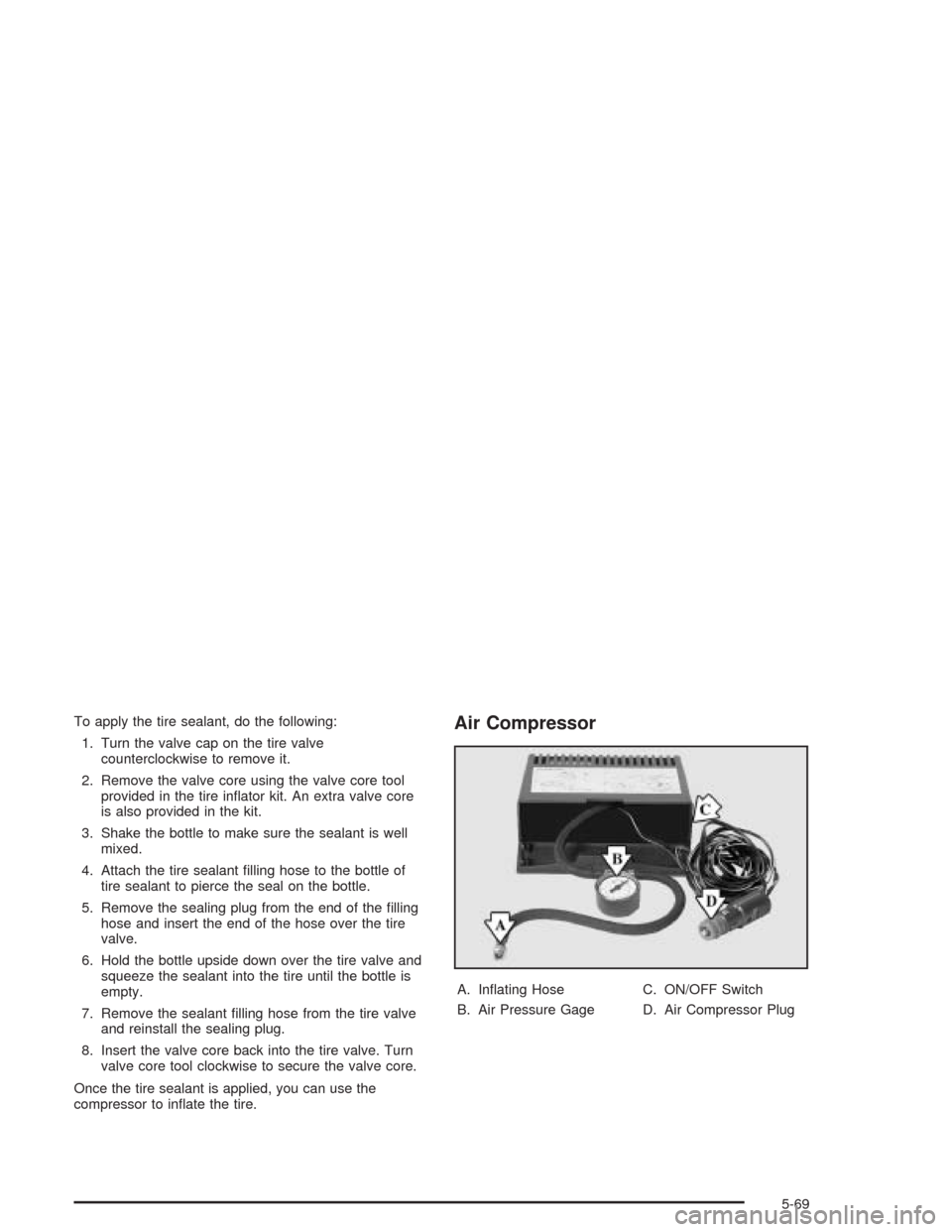
To apply the tire sealant, do the following:
1. Turn the valve cap on the tire valve
counterclockwise to remove it.
2. Remove the valve core using the valve core tool
provided in the tire in�ator kit. An extra valve core
is also provided in the kit.
3. Shake the bottle to make sure the sealant is well
mixed.
4. Attach the tire sealant �lling hose to the bottle of
tire sealant to pierce the seal on the bottle.
5. Remove the sealing plug from the end of the �lling
hose and insert the end of the hose over the tire
valve.
6. Hold the bottle upside down over the tire valve and
squeeze the sealant into the tire until the bottle is
empty.
7. Remove the sealant �lling hose from the tire valve
and reinstall the sealing plug.
8. Insert the valve core back into the tire valve. Turn
valve core tool clockwise to secure the valve core.
Once the tire sealant is applied, you can use the
compressor to in�ate the tire.Air Compressor
A. In�ating Hose
B. Air Pressure GageC. ON/OFF Switch
D. Air Compressor Plug
5-69
Page 326 of 398
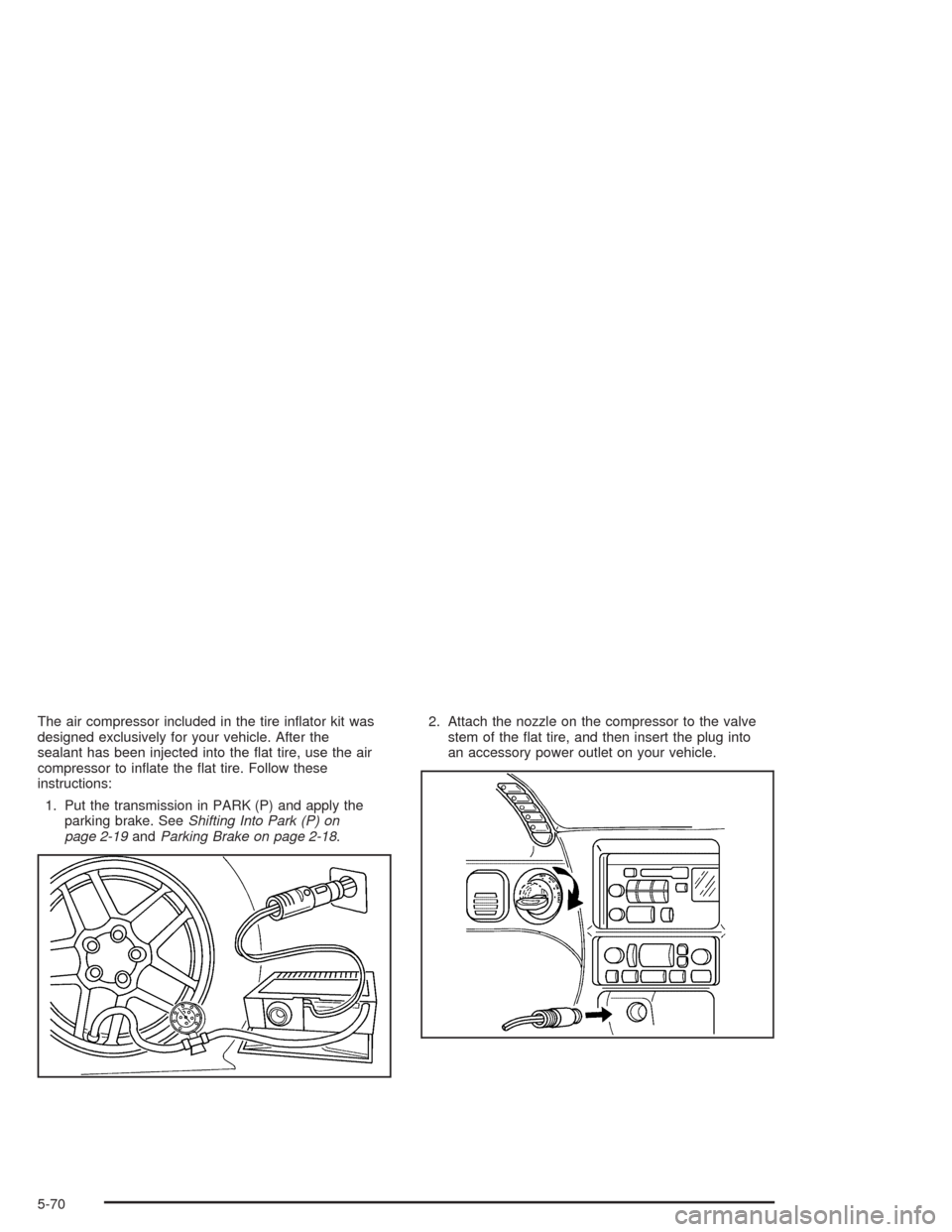
The air compressor included in the tire in�ator kit was
designed exclusively for your vehicle. After the
sealant has been injected into the �at tire, use the air
compressor to in�ate the �at tire. Follow these
instructions:
1. Put the transmission in PARK (P) and apply the
parking brake. SeeShifting Into Park (P) on
page 2-19andParking Brake on page 2-18.2. Attach the nozzle on the compressor to the valve
stem of the �at tire, and then insert the plug into
an accessory power outlet on your vehicle.
5-70
Page 327 of 398

{CAUTION:
Idling the engine in a closed-in place or with
the climate control system off can cause
deadly carbon monoxide (CO). See “Engine
Exhaust” in the Index.
Notice:The car engine must be running to avoid
draining the battery while running the air
compressor.
3. Start your vehicle.
4. Turn the compressor on to in�ate the tire.
{CAUTION:
In�ating something too much can make it
explode, and you or others could be injured.
Be sure to read the in�ator instructions, and
in�ate the tire to its recommended pressure.
Do not exceed 36 psi (248 kPa).
5. In�ate the tire to at
least 26 psi (179 kPa),
but not more than
36 psi (248 kPa).
5-71
Page 328 of 398

Notice:If the air compressor runs for more than
six minutes, at a time, it may overheat. The
excessive heat could damage the compressor.
Always operate the compressor for six minutes or
less when in�ating a tire.
6. In�ate the tire for
up to a maximum
of six minutes.
Notice:If 26 psi (179 kPa) tire pressure cannot be
reached after six minutes the vehicle should not
be driven further. Damage to the tire is severe and
the sealant will not be effective. Remove the air
compressor plug from the accessory power outlet
and unscrew the in�ating hose from the tire
valve. See “Roadside Assistance” in the Index.7. If 26 psi (179 kPa) tire pressure is reached in
six minutes or less, disconnect the air compressor.
8. Attach the enclosed
maximum speed label
to the inside upper
left corner of the
windshield or to the
face of the radio/clock.
The maximum speed label reminds you to drive
cautiously and not to exceed 55 mph (90 km/h)
until you have the damaged tire inspected
and repaired.
5-72
Page 329 of 398
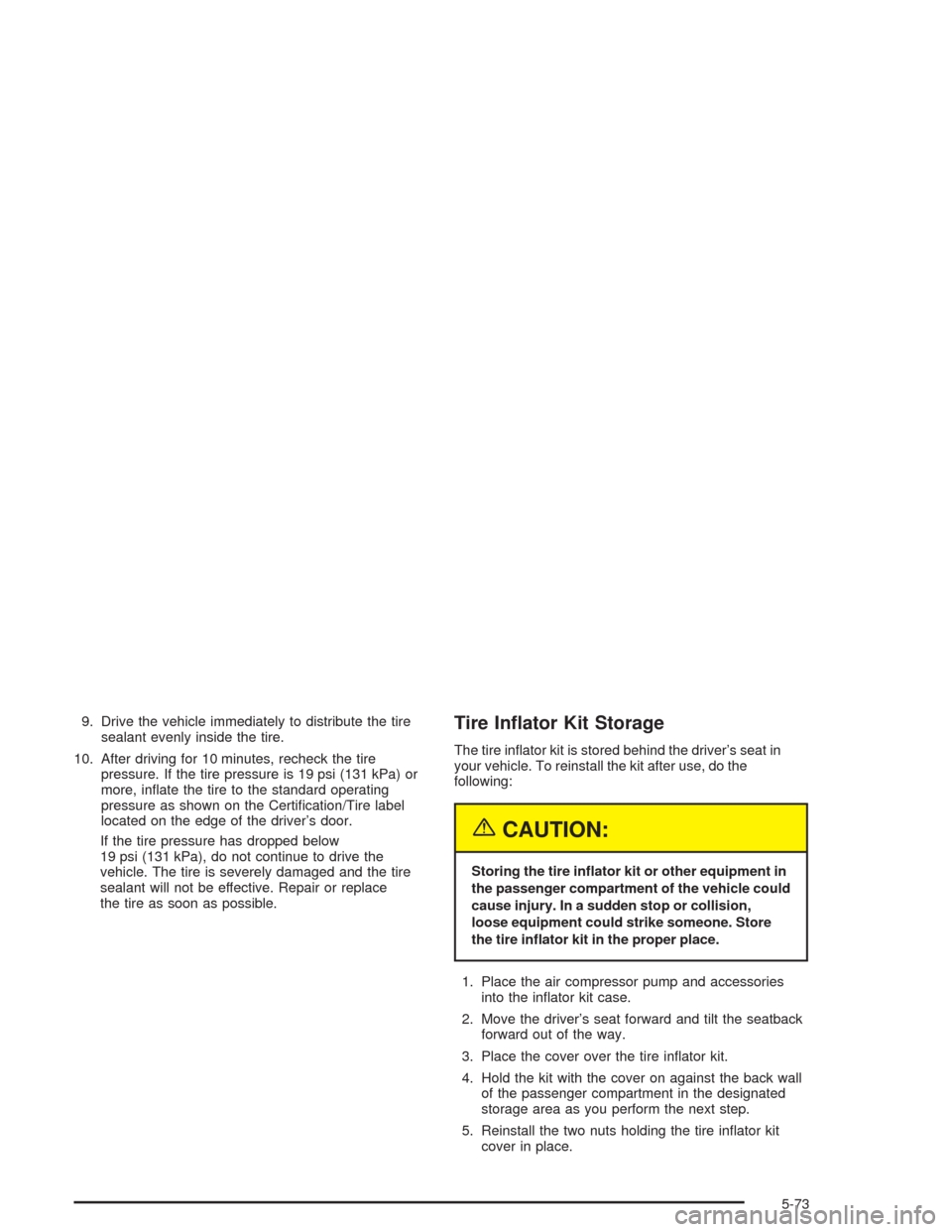
9. Drive the vehicle immediately to distribute the tire
sealant evenly inside the tire.
10. After driving for 10 minutes, recheck the tire
pressure. If the tire pressure is 19 psi (131 kPa) or
more, in�ate the tire to the standard operating
pressure as shown on the Certi�cation/Tire label
located on the edge of the driver’s door.
If the tire pressure has dropped below
19 psi (131 kPa), do not continue to drive the
vehicle. The tire is severely damaged and the tire
sealant will not be effective. Repair or replace
the tire as soon as possible.Tire In�ator Kit Storage
The tire in�ator kit is stored behind the driver’s seat in
your vehicle. To reinstall the kit after use, do the
following:
{CAUTION:
Storing the tire in�ator kit or other equipment in
the passenger compartment of the vehicle could
cause injury. In a sudden stop or collision,
loose equipment could strike someone. Store
the tire in�ator kit in the proper place.
1. Place the air compressor pump and accessories
into the in�ator kit case.
2. Move the driver’s seat forward and tilt the seatback
forward out of the way.
3. Place the cover over the tire in�ator kit.
4. Hold the kit with the cover on against the back wall
of the passenger compartment in the designated
storage area as you perform the next step.
5. Reinstall the two nuts holding the tire in�ator kit
cover in place.
5-73
Page 330 of 398
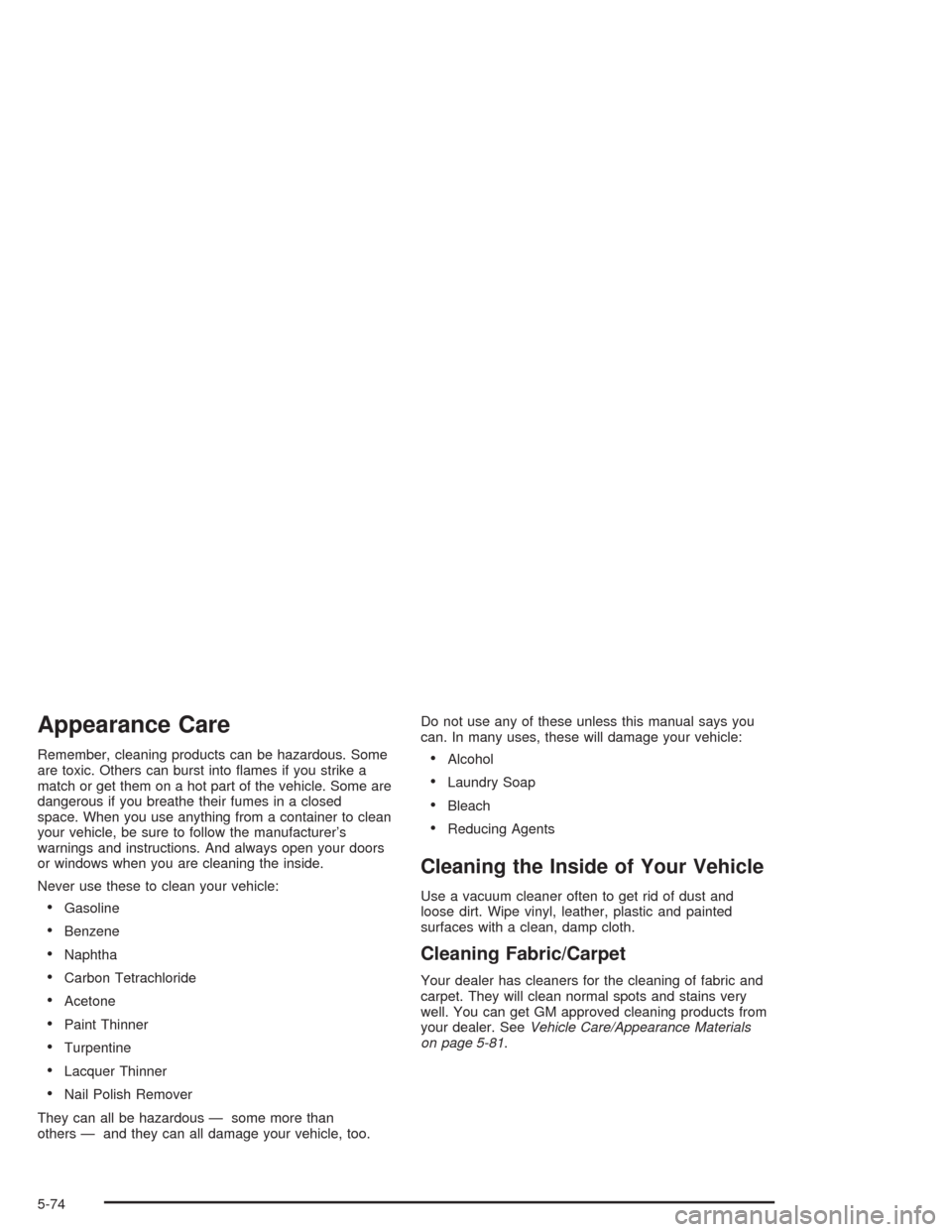
Appearance Care
Remember, cleaning products can be hazardous. Some
are toxic. Others can burst into �ames if you strike a
match or get them on a hot part of the vehicle. Some are
dangerous if you breathe their fumes in a closed
space. When you use anything from a container to clean
your vehicle, be sure to follow the manufacturer’s
warnings and instructions. And always open your doors
or windows when you are cleaning the inside.
Never use these to clean your vehicle:
Gasoline
Benzene
Naphtha
Carbon Tetrachloride
Acetone
Paint Thinner
Turpentine
Lacquer Thinner
Nail Polish Remover
They can all be hazardous — some more than
others — and they can all damage your vehicle, too.Do not use any of these unless this manual says you
can. In many uses, these will damage your vehicle:
Alcohol
Laundry Soap
Bleach
Reducing Agents
Cleaning the Inside of Your Vehicle
Use a vacuum cleaner often to get rid of dust and
loose dirt. Wipe vinyl, leather, plastic and painted
surfaces with a clean, damp cloth.
Cleaning Fabric/Carpet
Your dealer has cleaners for the cleaning of fabric and
carpet. They will clean normal spots and stains very
well. You can get GM approved cleaning products from
your dealer. SeeVehicle Care/Appearance Materials
on page 5-81.
5-74